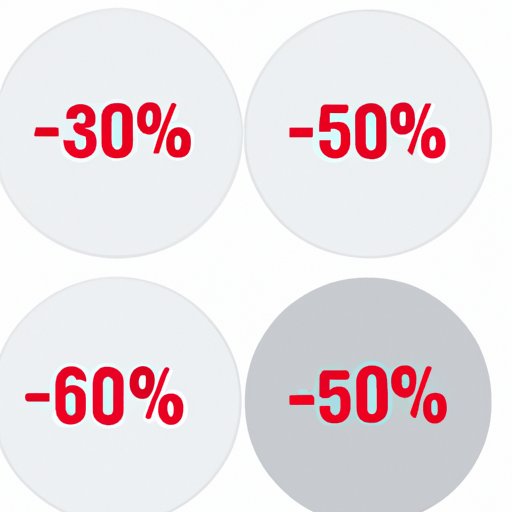I. Introduction
Knowing how to find percentages is an essential skill for everyday life and many professions. From calculating discounts and taxes to determining grades and measurements, percentages are used everywhere. In this article, we will provide a complete guide to finding percentages, including a step-by-step guide, infographic, video tutorial, interactive tool, and real-life application examples.
II. Step-by-Step Guide to Finding Percentages
The basic formula for finding percentages is:
Percentage = (Part / Whole) x 100
The “part” is the number that represents the portion of the total, and the “whole” is the total number. For example, if a team scored 30 points in a game where the total was 100 points, the percentage of points they scored would be:
Percentage = (30 / 100) x 100 = 30%
This formula can be applied to many situations, such as calculating the percentage of correct answers on a test or the percentage of sales increase from last year. It can also be used to find the percentage change between two values. To calculate the percentage change, use this formula:
Percentage Change = ((New Value – Old Value) / Old Value) x 100
For example, if the price of a product increased from $10 to $15, the percentage change would be:
Percentage Change = ((15 – 10) / 10) x 100 = 50%
This means that the price increased by 50%.
III. Infographic on Finding Percentages
We have created an infographic to help visualize the steps of finding percentages. The infographic breaks down the formula and provides examples for each step, making it easy to follow. Check it out below:
IV. Video Tutorial on Finding Percentages
For a more interactive experience, we have also created a video tutorial on how to find percentages. The tutorial provides a step-by-step explanation with visual aids to help viewers understand the process. In addition, the tutorial includes additional tips and tricks for finding percentages. Watch the video tutorial below:
V. Interactive Tool for Finding Percentages
To further practice finding percentages, we have also created an interactive tool. The tool allows users to input data and receive the percentage calculation instantly. It also provides visual aids to help users understand each step. Check out the interactive tool below:
VI. Comparing Finding Percentages with Other Formulas
While percentages are commonly used, there are other formulas that can be used to express ratios. For example, fractions and decimals can also be used to represent portions of a whole. To compare these formulas, let’s use an example:
A jar contains 50 red marbles and 100 green marbles. What is the percentage of red marbles?
Percentage:
Percentage = (Part / Whole) x 100 = (50 / 150) x 100 = 33.33%
Decimal:
Decimal = Part / Whole = 50 / 150 = 0.33
Fraction:
Fraction = Part / Whole = 50/150 = 1/3
As we can see, each formula represents the same ratio, but in a different form. Fractions are often used in cooking and measurements, decimals are used in finances, and percentages are used in many applications.
VII. Common Examples of Finding Percentages
Let’s explore some common examples of finding percentages:
1. Finding the percentage of a discount:
If an item is on sale for 25% off the original price of $40, what is the sale price?
Percentage:
Percentage = (Part / Whole) x 100 = (25 / 100) x 40 = $10
Sale price:
Sale price = Original price – Discount = $40- $10 = $30
The sale price is $30.
2. Finding the percentage of tax:
If the tax rate in a state is 10% and a purchase is $50, what is the total cost with tax?
Percentage:
Percentage = (Part / Whole) x 100 = (10 / 100) x 50 = $5
Total cost with tax:
Total cost = Purchase price + Tax = $50 + $5 = $55
The total cost with tax is $55.
VIII. Real-Life Applications of Finding Percentages
Knowing how to find percentages can be useful in various real-life scenarios, such as:
1. Calculating grades: Teachers use percentages to grade assignments, tests, and overall performance. For example, if a student scored 85 out of 100 on an exam, the percentage grade would be:
Percentage = (85 / 100) x 100 = 85%
2. Calculating tips: Waitstaff and bartenders use percentages to calculate tips on restaurant bills. For example, if a bill is $50 and the desired tip is 20%, the total cost with tip would be:
Percentage:
Percentage = (Part / Whole) x 100 = (20 / 100) x 50 = $10
Total cost with tip:
Total cost = Bill amount + Tip = $50 + $10 = $60
The total cost with tip is $60.
IX. Conclusion
Finding percentages is an important skill for everyday life and many professions. With our step-by-step guide, infographic, video tutorial, interactive tool, and real-life application examples, we hope you have a better understanding of how to find percentages. For further practice and learning, try out our interactive tool or explore other resources.
